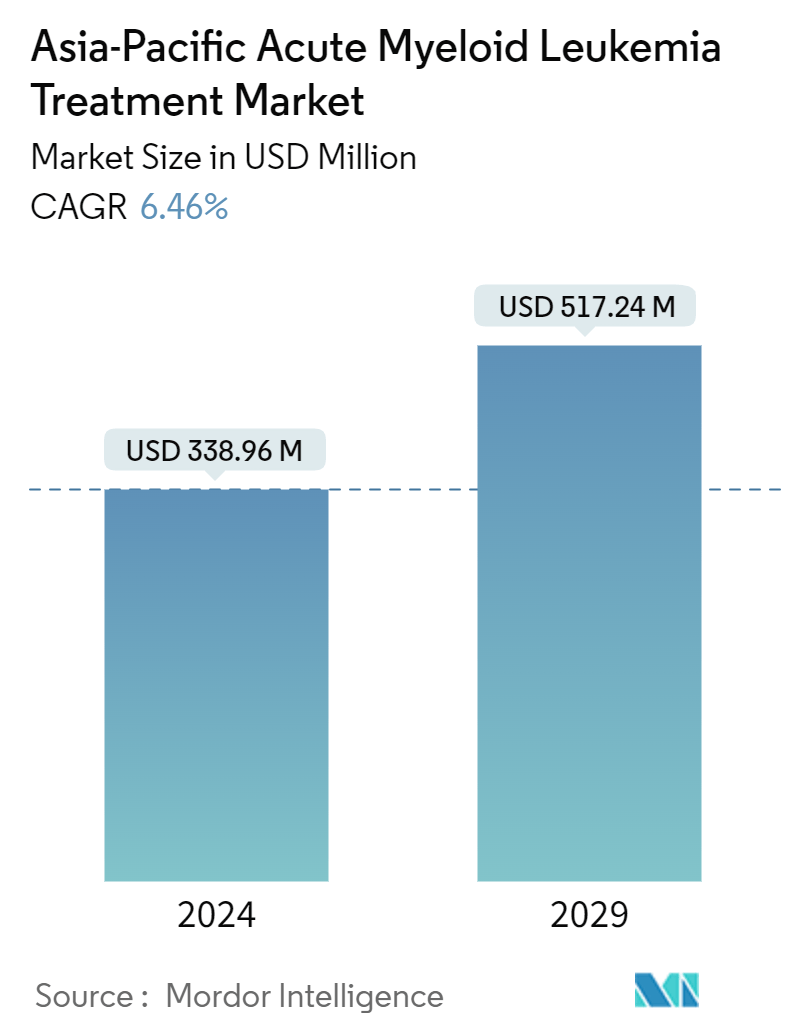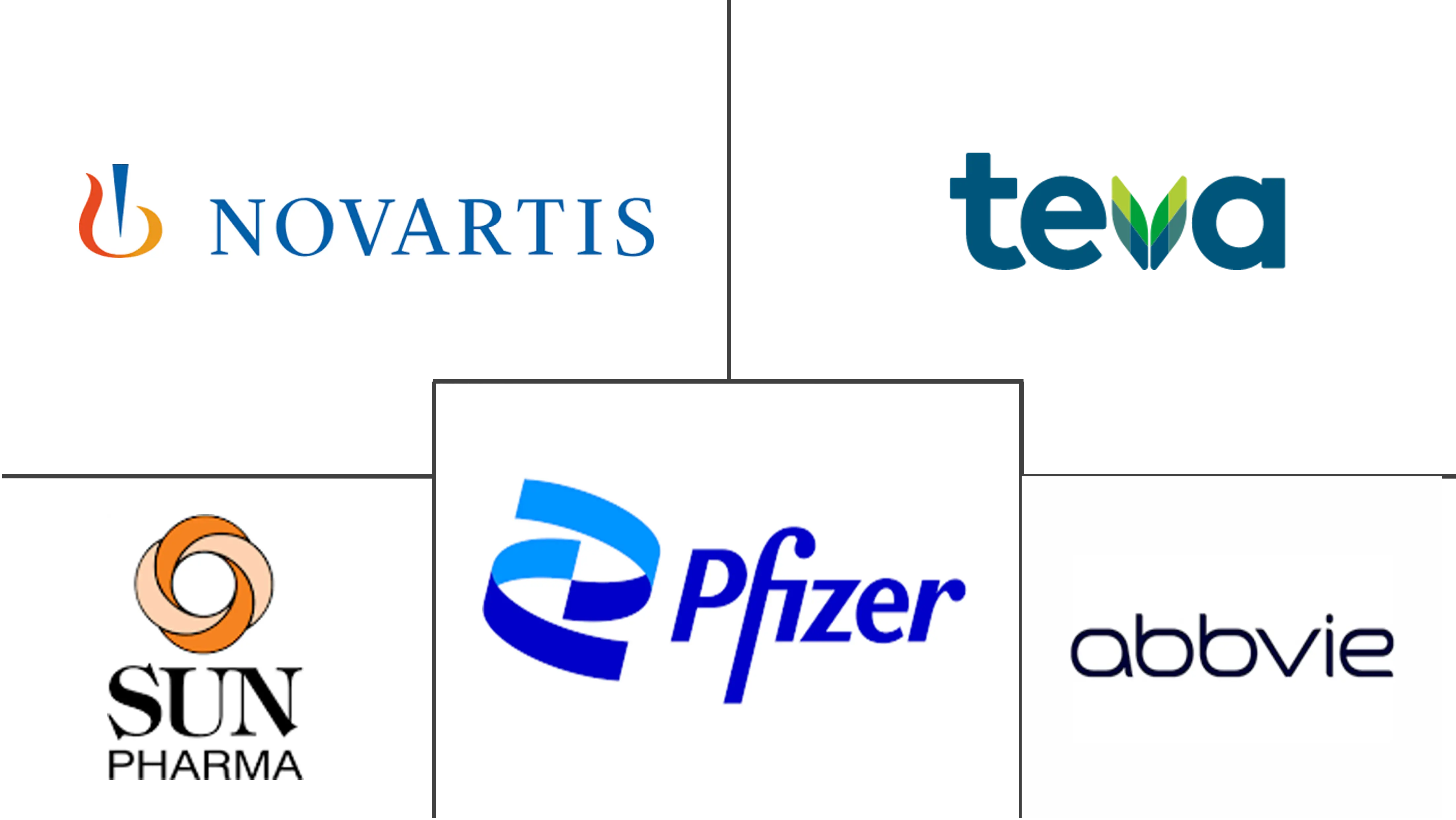Market Size of Asia-Pacific Acute Myeloid Leukemia Treatment Industry

| Study Period | 2019 - 2029 |
| Base Year For Estimation | 2023 |
| Forecast Data Period | 2024 - 2029 |
| Market Size (2024) | USD 338.96 Million |
| Market Size (2029) | USD 517.24 Million |
| CAGR (2024 - 2029) | 6.46 % |
Major Players
*Disclaimer: Major Players sorted in no particular order |
Asia-Pacific Acute Myeloid Leukemia Treatment Market Analysis
The Asia-Pacific Acute Myeloid Leukemia Treatment Market size is estimated at USD 338.96 million in 2024, and is expected to reach USD 517.24 million by 2029, growing at a CAGR of 6.46% during the forecast period (2024-2029).
Factors such as the high incidence and prevalence of acute myeloid leukemia and advancement in pharmacology and molecular biology to promote drug development in the Asia Pacific region are also anticipated to drive market growth over the forecast period. For instance, according to 'Leukaemia in Australia Statistics 2022', it was estimated that 5,202 new cases of leukemia were likely to be diagnosed in Australia (3,198 males and 2,004 females) in 2022. It was also estimated that a person had a 1 in 58 (or 1.7%) risk of being diagnosed with leukemia by the age of 85 (1 in 47 or 2.1% for males and 1 in 77 or 1.3% for females). Furthermore, government initiatives and funding for AML in the Asia Pacific region are likely to boost market growth.
According to a 2022 update from the Department of Health and Aged Care, from 1st March 2022, Australians with acute myeloid leukemia (AML) were likely to have access to a new treatment option through the Pharmaceutical Benefits Scheme (PBS). Mylotarg (gemtuzumab ozogamicin) was listed for the first time for the treatment of patients with previously untreated de novo CD33-positive AML, for use in combination with standard intensive chemotherapy.
The market is also expected to benefit from continuous developments in pharmacology and molecular biology for the creation of innovative medicines. Pharmaceutical companies competing in the market are investing a lot of money in research programs to develop new solutions. These R&D initiatives are also blamed for the shortcomings of the acute myeloid leukemia medicines now on the market. For instance, in August 2022, Daiichi Sankyo submitted a supplemental New Drug Application (NDA) to Japan's Ministry of Health, Labour and Welfare (MHLW) for quizartinib in combination with standard cytarabine and anthracycline induction and standard cytarabine consolidation chemotherapy and as continuation monotherapy for the treatment of adult patients in Japan with newly diagnosed FLT3-ITD positive acute myeloid leukemia (AML).
Thus, the high burden of acute myeloid leukemia advancement in pharmacology and molecular biology and strategic activities by the market players is expected to contribute to the market growth over the forecast period.
Asia-Pacific Acute Myeloid Leukemia Treatment Industry Segmentation
As per the scope of the report, acute myeloid leukemia is also known as acute myelogenous leukemia, acute myeloblastic leukemia, acute granulocytic leukemia, or acute non-lymphocytic leukemia. In acute myeloid leukemia, there is a rapid production of abnormal white blood cells, which get collected in the bone marrow and disturb the production of normal blood cells.
The Asia-Pacific acute myeloid leukemia treatment market is segmented by therapy and geography. By Therapy the market is segmented as chemotherapy targeted therapy, stem cell transplant, and other therapies. By geography, the market is segmented as China, Japan, India, Australia, South Korea, and the Rest of Asia-Pacific. The report offers the value (in USD) for the above segments.
| By Therapy | ||||||
| ||||||
| Targeted Therapy | ||||||
| Stem Cell Transplant | ||||||
| Other Therapies |
| Geography | |
| China | |
| Japan | |
| India | |
| Australia | |
| South Korea | |
| Rest of Asia-Pacific |
Asia-Pacific Acute Myeloid Leukemia Treatment Market Size Summary
The Asia-Pacific acute myeloid leukemia (AML) treatment market is poised for significant growth, driven by the high incidence and prevalence of the disease, alongside advancements in pharmacology and molecular biology. These advancements are facilitating the development of innovative therapies, which are expected to enhance treatment options across the region. Government initiatives and funding are also playing a crucial role in supporting market expansion. The introduction of new treatment options, such as Mylotarg in Australia, highlights the region's commitment to improving AML care. The market is characterized by active research and development efforts, with pharmaceutical companies investing heavily to bring new solutions to market, addressing the limitations of existing therapies.
Chemotherapy remains the primary treatment modality for AML, with both induction and consolidation phases being critical for patient recovery. The chemotherapy segment is anticipated to experience growth due to the increasing demand for therapeutics, spurred by the rising prevalence of AML. China is expected to hold a significant market share, supported by advancements in targeted therapies and stem cell transplants. The market's semi-consolidated nature, with key global players like Novartis AG, Pfizer Inc., and AbbVie Inc., underscores the competitive landscape. Strategic activities, including product launches and clinical trials, are further propelling market growth, with companies like CStone and HUTCHMED making notable strides in AML treatment advancements.
Asia-Pacific Acute Myeloid Leukemia Treatment Market Size - Table of Contents
-
1. MARKET DYNAMICS
-
1.1 Market Overview
-
1.2 Market Drivers
-
1.2.1 High Incidence and Prevalence of Acute Myeloid Leukemia
-
1.2.2 Advancement in Pharmacology and Molecular Biology to Promote Drug Development
-
-
1.3 Market Restraints
-
1.3.1 Complications Related to Chemotherapy
-
-
1.4 Porter's Five Forces Analysis
-
1.4.1 Threat of New Entrants
-
1.4.2 Bargaining Power of Buyers/Consumers
-
1.4.3 Bargaining Power of Suppliers
-
1.4.4 Threat of Substitute Products
-
1.4.5 Intensity of Competitive Rivalry
-
-
-
2. MARKET SEGMENTATION (Market Size by Value - USD)
-
2.1 By Therapy
-
2.1.1 Chemotherapy
-
2.1.1.1 Anthracycline Drugs
-
2.1.1.2 Alkylating Agents
-
2.1.1.3 Anti-metabolites
-
2.1.1.4 Other Chemotherapies
-
-
2.1.2 Targeted Therapy
-
2.1.3 Stem Cell Transplant
-
2.1.4 Other Therapies
-
-
2.2 Geography
-
2.2.1 China
-
2.2.2 Japan
-
2.2.3 India
-
2.2.4 Australia
-
2.2.5 South Korea
-
2.2.6 Rest of Asia-Pacific
-
-
Asia-Pacific Acute Myeloid Leukemia Treatment Market Size FAQs
How big is the Asia-Pacific Acute Myeloid Leukemia Treatment Market?
The Asia-Pacific Acute Myeloid Leukemia Treatment Market size is expected to reach USD 338.96 million in 2024 and grow at a CAGR of 6.46% to reach USD 517.24 million by 2029.
What is the current Asia-Pacific Acute Myeloid Leukemia Treatment Market size?
In 2024, the Asia-Pacific Acute Myeloid Leukemia Treatment Market size is expected to reach USD 338.96 million.

